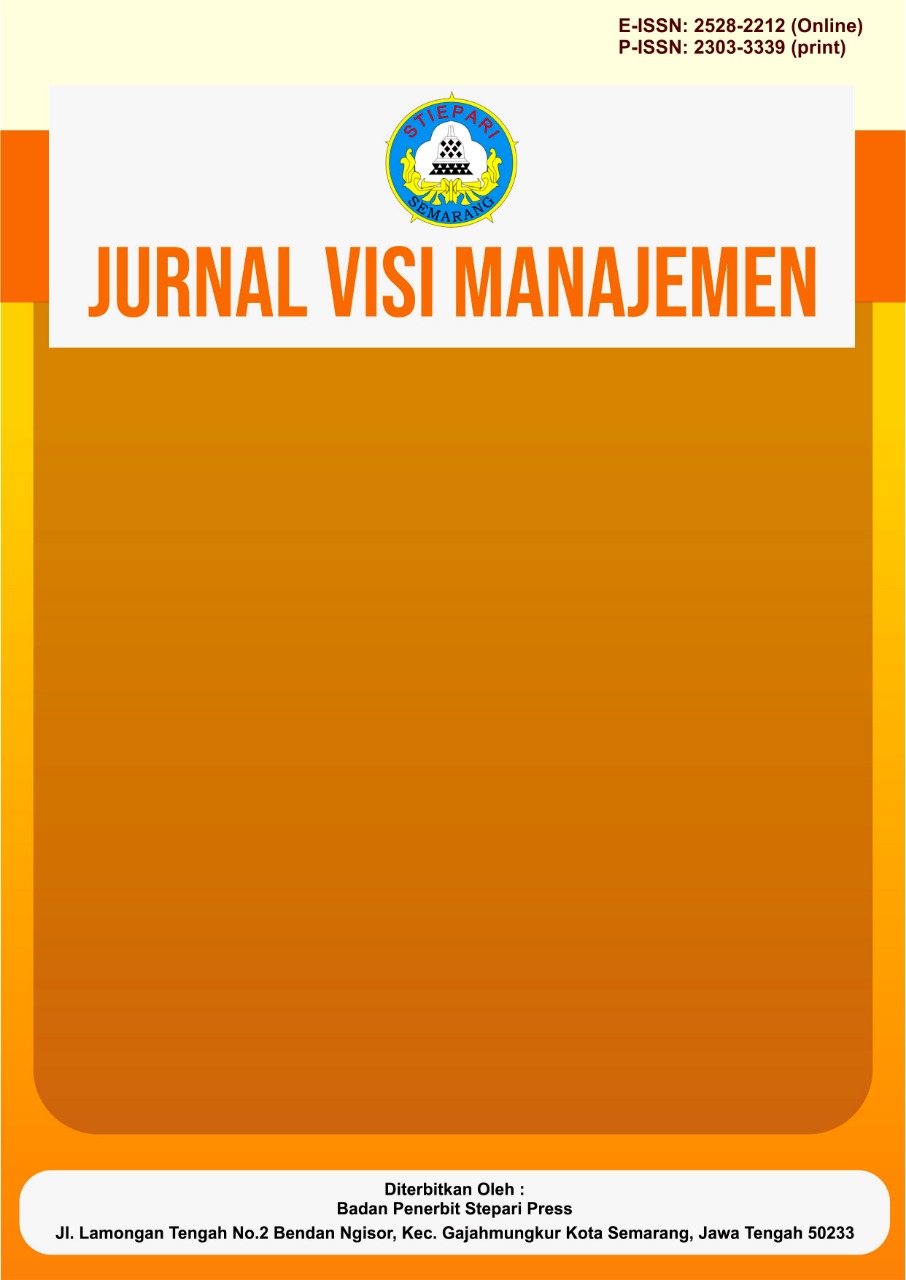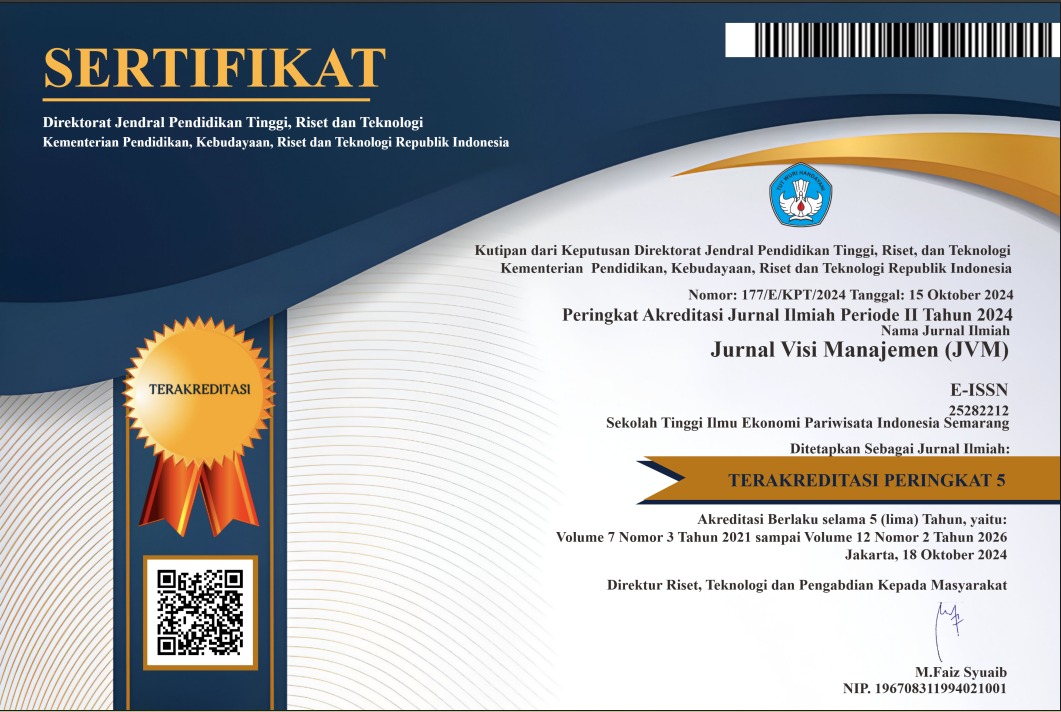Analisis Pengaruh Konsumsi Listrik dan Konsumsi Bahan Bakar Fosil Terhadap Eksternalitas Negatif Emisi Gas Rumah Kaca di Indonesia
DOI:
https://doi.org/10.56910/jvm.v11i2.548Keywords:
Electricity Consumption, Energy Consumption, Fossil Fuel Consumption, Greenhouse Gas, Negative ExternalitiesAbstract
The current warming trend is a negative externality of human activities since the mid-1800s and is proceeding at a pace unprecedented over the past millennia, such as increased energy consumption leading to an increase in the concentration ofCO2 gas and other gases in the atmosphere. CO2 gas has the largest contribution to global warming at about 56%. Increased energy consumption that causes an increase inCO2 gas because the use of energy consumption in Indonesia is still dominated by fossil energy consumption produced from fossil fuels and often uses technology that is not environmentally friendly so that it can trigger an increase in Greenhouse Gas (GHG) emissions which is the largest contributor to global warming. In response to this warming trend, Indonesia has ratified the Kyoto Protocol in 1997 into Law Number 17 of 2004 and the Paris Agreement into Law Number 16 of 2016 in an effort to reduce the temperature rise limit to 1.5°C above the earth's temperature in pre-industrial times. The objectives of this study are (1) To analyze the effect of electricity consumption and fossil fuel consumption simultaneously on the negative externalities of GHG emissions in Indonesia. (2) To analyze the effect of electricity consumption and fossil fuel consumption partially on the negative externalities of GHG emissions in Indonesia. The data used is secondary data, with multiple linear analysis techniques. The results showed that (1) Electricity consumption and fossil fuel consumption simultaneously affect the negative externalities of GHG emissions in Indonesia. (2) Electricity consumption partially has a positive and significant effect on the negative externalities of GHG emissions in Indonesia. (3) Fossil fuel consumption partially has a positive and insignificant effect on the negative externalities of GHG emissions in Indonesia.
Keywords: Greenhouse Gas, Negative Externalities, Energy Consumption, Electricity Consumption, Fossil Fuel Consumption
References
Abdulah, M. H. (2019). Relevansi Teori Environmental Kuznets Curve terhadap Degradasi Lingkungan di Tiga Klasifikasi Negara Tahun 1985-2014.
Abokyi, E., Appiah-Konadu, P., Sikayena, I., & Oteng-Abayie, E. F. (2018). Consumption of Electricity and Industrial Growth in the Case of Ghana. Journal of Energy, 2018. https://doi.org/10.1155/2018/8924835
Afriyanti, Y., Sasana, H., & Jalunggono, G. (2020). Analisis Faktor-faktor yang Mempengaruhi Konsumsi Energi Terbarukan di Indonesia. Journal of Economic, 2(3). https://doi.org/10.24036/jkep.v3i2.11594
Agustin, S. I., & Suhartini, A. M. (2023). Hubungan Simultanitas antara Emisi Gas Rumah Kaca dan Industrialisasi di Indonesia Tahun 1990-2019. Seminar Nasional Official Statistics. https://doi.org/10.34123/semnasoffstat.v2023i1.1817
Aji, S. M. B., Adliawan, I., & Kawahyuning, D. I. (2024). Dampak Pemanfaatan Energi, Perkembangan Ekonomi, dan Wilayah Hutan terhadap emisi gas rumah kaca di AS, Rusia, Cina, dan Brasil. Jurnal Ekonomi Manajemen Dan Sosial, 7(1), 11-25. https://ojs.ejournalunigoro.com/index.php/JEMeS
Arsyad, L. (1992). Pembangunan Ekonomi (2nd ed.). STIE YKPN.
Asian Development Bank. (2023). Asian Development Outlook April 2023.
Ayres, R., & Warr, B. (2009). The Economic Growth Engine, How Energy and Work Drive Material Prosperity. Edward Elgar. https://doi.org/10.4337/9781848445956
Bachtiar, A. Z. (2019). Analisis Pengaruh Tenaga Kerja Informal, Pengangguran, dan Pendidikan Terhadap Pertumbuhan Ekonomi di Indonesia. Jurnal Ilmiah Mahasiswa FEB, 7(2).
Badan Pusat Statistik. (2023). Laporan Perekonomian Indonesia 2023.
Berlianto, D. M. F., & Wijaya, R. S. (2022). Pengaruh Transisi Konsumsi Energi Fosil Menuju Energi Baru Terbarukan terhadap Produk Domestik Bruto di Indonesia. Jurnal Perspektif Ekonomi Dan Pembangunan Daerah, 11(2). https://doi.org/10.22437/pdpd.v11i2.17944
BMKG. (2011). Adaptasi dan Mitigasi Perubahan Iklim di Indonesia.
Budiwan, I. (2020). Analisis Pengaruh Konsumsi Energi terhadap Pertumbuhan Ekonomi dan Emisi Karbon Dioksida di Indonesia. Intitut Pertanian Bogor.
Darmayanti, L. P. (2018). Analisis Hubungan Konsumsi Listrik dengan Pertumbuhan Ekonomi di Indonesia Tahun 1971 - 2014.
Devy, F. A. S., TN, A. Z., & Djoemadi, F. R. (2019). Konsumsi Listrik Dan Pertumbuhan Ekonomi Di Indonesia, 1995-2015. Jurnal Ilmiah Mahasiswa Universitas Surabaya, 7(2).
Dewan Riset Nasional. (2011). Iptek untuk perubahan Iklim Kajian Kebutuhan Tema Riset Prioritas.
Fariz, M., & Muljaningsih, S. (2015). Pengaruh Konsumsi Energi terhadap Pertumbuhan Ekonomi di Indonesia Periode 1980-2012. Jurnal Ilmiah.
Fauzi, R. (2017). Pengaruh Konsumsi Energi, Luas Kawasan Hutan dan Pertumbuhan Ekonomi terhadap Emisi CO2 di 6(Enam)NegaraAnggota ASEAN : PendekatanAnalisis Data Panel. 11(1). http://data.worldbank.org/ https://doi.org/10.20886/JKLH.2017.11.1.14-26
Ghozali, I. (2018). Aplikasi Analisis Multivariete SPSS 25 (9th ed.). Badan Penerbit Universitas Diponogoro.
Global Climate & SDG Synergy Conference. (2022). Third Global Conference on Strengthening Synergies Between the Paris Agreement and the 2030 Agenda For Sustainable Development. https://www.un.org/en/climate-sdgs-conference-2022.
Gunawan, M. H. (2020). Pertumbuhan Ekonomi dalam Pandangan Ekonomi Islam.
Harris, J. M., & Roach, B. (2018). Environmental and Natural Resource Economics A Contemporary Approach (Fourth). Routledge.
https://doi.org/10.4324/9781315620190
Huda, N. (2015). Ekonomi Pembangunan Islam. Prenada Media.
International Monetary Fund. (2023). World Economic Outlook : A Rocky Recovery. International Monetary Fund.
Irawan, & M. Suparmoko. (2008). Ekonomika Pembangunan (6th ed.). BPFE.
Jhingan, M. L. (2003). Ekonomi Pembangunan dan Perekonomian. PT. Raya Grafindo Persada.
Kementerian ESDM. (2023). Laporan Kinerja 2023. www.migas.esdm.go.id
Kementerian Lingkungan Hidup dan Kehutanan. (2023). Laporan Kinerja 2023.
Kemlu. (2018). Sekilas tentang Indonesia. Kementerian Luar Negeri Republik Indonesia.
KOMINFO. (2023, March 20). Kondisi Bumi Kian Mengkhawatirkan, BMKG Ajak Masyarakat Kontribusi Tahan Laju Perubahan Iklim. Artikel GPR.
Kurniarahma, L., Lorentino, T. L., & Prasetyanto, P. K. (2020). Analisis Faktor-faktor yang Mempengaruhi Emisi CO2 di Indonesia. Journal of Economic, 2(2).
Lau, E., Chye, X. H., & Choong, C. K. (2011). Energy-growth causality: Asian countries revisited. International Journal of Energy Economics and Policy, 1, 140-149.
Lean, H. H., & Smyth, R. (2010). CO2 Emissions, Electricity Consumption and Output in ASEAN. Applied Energy, 87(6). https://doi.org/10.1016/j.apenergy.2010.02.003
Mahira, D. I. (2022). Analisis Pengaruh Konsumsi Energi, Pertumbuhan Ekonomi dan Luas Kawasan Hutan terhadap Emisi Gas Rumah Kaca di 5 Negara Asean: Pendekatan Data Panel.
Mankiw, N. G. (2007). Makroekonomi (6th ed.). Erlangga.
Mirzaei, M., & Bekri, M. (2017). Energy Consumption and CO2 Emissions in Iran, 2025. Environmental Research, 154. https://doi.org/10.1016/j.envres.2017.01.023
Nadeak, S. A. H., & Nasrudin. (2023). Pengaruh PDB per Kapita dan Konsumsi Energi terhadap Emisi GRK di Indonesia. Jurnal Ekonomi Dan Pembangunan Indonesia, 23(2), 128-145. https://doi.org/10.21002/jepi.2023.09
NASA. (2023, December). The Causes of Climate Change. Causes.
Nikensari, I., Destilawati, S., & Nurjanah, S. (2019). Studi Environmental Kuznets Curve di Asia: Sebelum dan Setelah Millennium Development Goals. Ekonomi Dan Pembangunan, 27(2). https://doi.org/10.14203/JEP.27.2.2019.11-25
Noor, S., & Siddiqi, M. W. (2010). Energy Consumption and Economic Growth in South Asian Countries: A Co-Integrated Panel Analysis. World Academy of Science, Engineering and Technology , 4.
OECD. (2019). OECD Green Growth Policy Review of Indonesia 2019 (OECD Environmental Performance Reviews). OECD.
Our World in Data. (2023). Fossil Fuel Consumption (kWh per capita).
Our World in Data. (2023). Total Greenhouse Gas Emissions (kt of CO2 equivalent) - Indonesia.
Patrianti, T., Shabana, A., & Tuti, R. W. (2020). Komunikasi Risiko Pemerintah pada Penurunan Emisi Gas Rumah Kaca untuk Mengatasi Perubahan Iklim. Jurnal Penelitian Komunikasi Dan Opini Publik, 24(2). https://doi.org/10.33299/jpkop.24.2.3416
Pratama, R. (2019). Efek Rumah Kaca Terhadap Bumi. Cetak) Buletin Utama Teknik, 14(2), 1410-4520.
Pratiwi, D. R. (2021). Analisis Hubungan Kausalitas Pertumbuhan Ekonomi, Konsumsi Energi, dan Emisi CO2 di Indonesia pada Periode 1980-2019. Budget, 6(1), 2021. https://doi.org/10.22212/jbudget.v6i1.67
PT PLN (PERSERO. (2022). Statistik PLN. www.pln.co.id
Rifais, A. (2018). Prediksi Konsumsi Energi Listrik Menggunakan Metode Jaringan Syaraf Tiruan Recurrent di PLN APJ Salatiga.
Sampurna, I. P., & Nindhia, T. S. (2018). Metodologi Penelitian dan Karya Ilmiah.
Samuelson, P. A., & Nordhaus, W. D. (2001). Microeconomics (17th ed.). Mc Graw-Hill.
Sasana, H., & Aminata, J. (2019). Energy Subsidy, Energy Consumption, Economic Growth, and Carbon Dioxide Emission: Indonesian Case Studies. International Journal of Energy Economics and Policy, 9(2). https://doi.org/10.32479/ijeep.7479
Sinthiya, I. A. P. A., & Kusnadi, D. (2018). Analisis Emisi Gas Rumah Kaca (GRK) dan Pemetaan Zona Emisi Menggunakan GIS (Geospasial Information System) di Kabupaten Pringsewu, Lampung. Sistem Informasi Dan Telematika, 9(2). https://doi.org/10.36448/jsit.v9i2.1078
Sugiyono, A. (2006). Penanggulangan Pemanasan Global Disektor Pengguna Energi. Jurnal Sains & Teknologi Modifikasi Cuaca, 7(2).
Sugiyono. (2018). Metode Penelitian Kuantitatif, Kualitatif, dan Kombinasi (Mixed Methods) (2nd ed.). Alfabeta.
Sukirno, S. (1998). Pengantar Teori Mikroekonomi (2nd ed.). RajaGrafindo Persada.
Sukirno, S. (2000). Makroekonomi Modern. PT Raja Drafindo Persada.
Tarigan, R. (2005). Ekonomi Regional Teori dan Aplikasi. PT. Bumi Aksara.
Thaker, M. A., Thaker, H. M., Amin, M. F., & Pitchay, A. A. (2019). Electricity Consumption and Economic Growth : A Revisit Study of Their Causality in Malaysia. Etikonomi, 18(1). https://doi.org/10.15408/etk.v18i1.7455
Todaro, M. P., & Smith, S. C. (2006). Pembangunan Ekonomi (Sembilan). Erlangga. https://books.google.co.id/books?id=m8kMk_KbSX4C&lpg=PR4&hl=id&pg=PR4#v=onepage&q&f=false
Todaro, M. P., & Smith, S. C. (2011). Pembangunan Ekonomi (Sebelas). Erlangga.
Tsandra, N. A., Sunaryo, R. P., & Octaviani, D. (2023). Pengaruh Konsumsi Energi dan Aktivitas Ekonomi Terhadap Emisi CO2 di Negara G20. Journal Ekonomi Bisnis Dan Akuntansi, 10(2), 69-79. https://doi.org/10.19184/ejeba.v10i2.39278
United Nations. (1998). Kyoto Protocol to The United Nations Framework Convention on Climate Change.
Wang, Z., Li, Z., Lei, T., Yang, M., Qi, T., Lin, L., Xin, X., Ajayebi, A., Yang, Y., He, X., & Yan, X. (2016). Life Cycle Assessment of Energy Consumtion and Environmental Emissions for Cornstalk-Based Ethyl Levulinate. Applied Energy, 183. https://doi.org/10.1016/j.apenergy.2016.08.187
World Bank. (2023). Electric Power Consumption (kWh per capita) - Indonesia.
World Bank. (2023). GDP Growth (annual %) - Indonesia.
Yoo, S.-H. (2006). The Causal Relationship between Electricity Consumption and Economic Growth in the ASEAN Countries. Energy Policy, 34(18). https://doi.org/10.1016/j.enpol.2005.07.011
Zhu, H., Duan, L., Guo, Y., & Yu, K. (2016). The effects of FDI, economic growth and energy consumption on carbon emissions in ASEAN-5: Evidence from panel quantile regression. Economic Modelling, 58, 237-248. https://doi.org/10.1016/j.econmod.2016.05.003
Zulaicha, A. U., Sasana, H., & Septiani, Y. (2020). Analisis Determinasi Emisi CO2 di Indonesia Tahun 1990-2018. Economic, 2(2).
Downloads
Published
How to Cite
Issue
Section
License
Copyright (c) 2025 Jurnal Visi Manajemen

This work is licensed under a Creative Commons Attribution-ShareAlike 4.0 International License.







